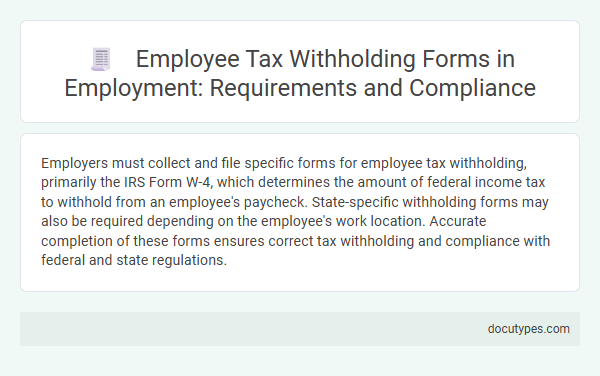Employers must collect and file specific forms for employee tax withholding, primarily the IRS Form W-4, which determines the amount of federal income tax to withhold from an employee's paycheck. State-specific withholding forms may also be required depending on the employee's work location. Accurate completion of these forms ensures correct tax withholding and compliance with federal and state regulations.
Introduction to Employee Tax Withholding Forms
Employee tax withholding forms are essential documents used by employers to accurately deduct the correct amount of taxes from an employee's paycheck. Understanding which forms are required helps ensure compliance with tax regulations.
The most common form for employee tax withholding is the W-4, which provides information on filing status and allowances. Employers rely on this form to calculate federal income tax withholding. Other supplementary forms may be needed for state or local tax requirements depending on the employee's location.
Legal Requirements for Tax Withholding in Employment
Employers must comply with specific legal requirements for employee tax withholding to ensure proper federal and state taxation. You need to complete and submit the correct forms to avoid penalties and ensure accurate tax reporting.
- Form W-4 - This form determines the amount of federal income tax withholding based on an employee's filing status and allowances.
- Form I-9 - Required to verify employment eligibility and identity, ensuring compliance with immigration laws.
- State Withholding Forms - Many states require additional withholding certificates specific to state income tax regulations.
Types of Tax Withholding Forms (W-4, State Forms, etc.)
Which forms are required for employee tax withholding? Employees must complete the federal W-4 form to determine the correct amount of federal income tax to withhold from their paychecks. State tax withholding forms vary by state and may also be necessary to ensure proper state income tax deductions.
How to Properly Complete Tax Withholding Forms
| Form Name | Purpose | How to Properly Complete |
|---|---|---|
| W-4 (Employee's Withholding Certificate) | Determines federal income tax withholding from an employee's paycheck |
- Enter personal information accurately, including name, address, Social Security number. - Indicate filing status (Single, Married, or Head of Household). - Claim dependents using the worksheets provided. - Include any additional income, deductions, or extra withholding amounts. - Sign and date the form before submission. - Submit a new W-4 if personal or financial situations change. |
| I-9 (Employment Eligibility Verification) | Verifies identity and employment authorization of employees |
- Complete Section 1 on or before the first day of employment. - Provide accurate personal details. - Review acceptable documents list from List A or Lists B and C. - Employer completes Section 2 within three business days using original documents. - Avoid expired or altered documents. - Keep the form on file for inspection but do not submit to the government. |
| State Tax Withholding Form (Varies by State) | Determines state income tax withholding applicable to the employee |
- Obtain the correct form according to the employee's state. - Provide accurate information such as residency status and allowances. - Follow state-specific instructions for claiming exemptions or additional withholding. - Sign and date the form. - Update the form as required by state law or when employee circumstances change. |
Employer Responsibilities in Tax Withholding Compliance
Employers must accurately complete and maintain specific tax withholding forms to ensure compliance with federal and state regulations. Proper management of these documents is crucial for correct payroll processing and avoiding legal penalties.
- Form W-4 - Employees complete this form to specify federal income tax withholding preferences.
- Form I-9 - Employers verify employee eligibility to work in the United States using this form.
- State Tax Withholding Forms - These vary by state and determine the amount of state income tax to withhold from employee wages.
You must retain these forms throughout the employment period and update them as necessary to maintain compliance with tax withholding requirements.
Common Mistakes in Employee Tax Withholding Forms
Accurate completion of employee tax withholding forms like the W-4 is crucial to ensure proper tax deductions. Common mistakes include incorrect filing status, neglecting to update allowances, and failing to submit the form promptly, which can lead to unexpected tax liabilities. Review your submitted forms carefully to avoid these errors and ensure compliance with IRS requirements.
Consequences of Non-Compliance with Tax Withholding Laws
Understanding the necessary forms for employee tax withholding is crucial to avoid legal and financial penalties. Failure to comply with tax withholding laws can lead to severe consequences for both employers and employees.
- Penalties and Fines - Employers may face substantial monetary penalties imposed by the IRS for incorrect or missing tax withholding forms.
- Employee Tax Liability - Employees might incur unexpected tax bills and interest charges if withholding is inaccurate or incomplete.
- Legal Action - Persistent non-compliance can trigger audits and potential legal proceedings against the employer.
Updating and Maintaining Accurate Withholding Records
Accurate employee tax withholding requires proper documentation, including Form W-4, Employee's Withholding Certificate. This form captures essential information to determine withholding allowances and tax status.
Updating and maintaining withholding records involve reviewing changes in marital status, dependents, or additional income to adjust tax withholdings accordingly. You must keep employees' forms current to avoid incorrect tax deductions and ensure compliance with IRS regulations.
Employee Guidance and Resources for Withholding Forms
Employees must complete specific tax withholding forms to ensure accurate payroll deductions. The most common form is the W-4, which determines federal income tax withholding based on personal information and allowances.
Guidance for completing withholding forms is available from the IRS website and employer human resources departments. Employees can also access state-specific withholding forms and instructions to comply with local tax regulations.
Which Forms Are Needed for Employee Tax Withholding? Infographic

